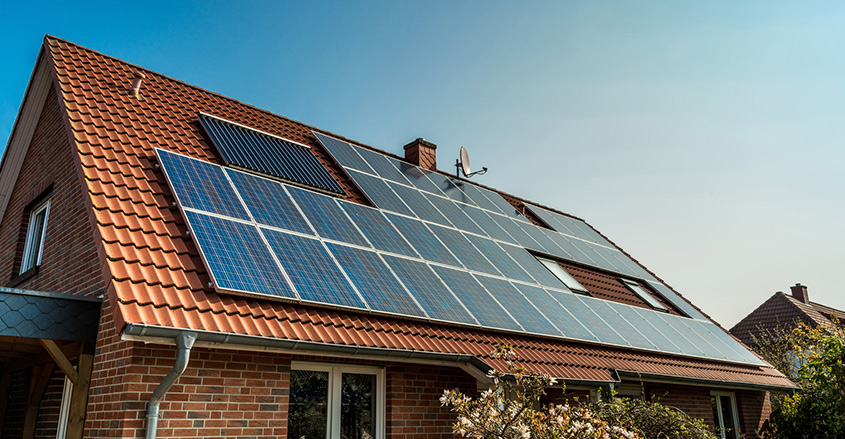Home solar is becoming a reality for many Americans, not just a hobby for the rich. In fact, California just mandated home solar for all new construction in the state.
Everyday energy consumption is what drives most to consider home solar energy generation. What could be better than taking control of your own energy costs, lowering your bills, and not having to depend on the local utility company?
The average American pays anywhere about $112 a month their residential energy bills. That’s more than $1,300 a year that could be recouped by a timely investment in home solar.
Nothing in life is ever that simple. Fitting your roof with photovoltaic solar panels is not an easy process. Such a conversion should be performed by licensed and certified professionals.
You also have to get authorization from your local utility company and municipal authority. Adapting your home for solar energy doesn’t mean freedom from the energy company, really, just the potential for lower bills.
Making a return on your home solar investment is a process that can take decades. Plus, your home has to be in a region with regular, direct periods of overhead sunlight coverage to make the most of a solar energy conversion.
Thus you must consider a multitude of factors before deciding to convert your home to generate solar energy. Otherwise, you could just be wasting a lot of money.
Get ahead of the curve
Big businesses and global corporations are preparing themselves to convert their everyday operational functions to accommodate renewable energy sources, including solar energy.
However, many seem to be waiting until the last optimal moment to do so. Our world still runs mostly on fossil fuels. Converting the current global energy consumption infrastructure will be a Herculean endeavor. The cost is nearly incalculable.
The world currently uses more than 90 million barrels of oil a day by conservative estimates. At that rate, the world will run out of oil in between 50 and 55 years.
That gives business time to calculate when it should move to a new energy infrastructures. Big businesses and corporations also have the benefit of solar energy investment tax credits. The U.S. government refunds and rebates businesses and corporations via tax incentives to embrace solar energy.
Assess your energy consumption
Why do you need to know this? Well, sooner or later, the world will have to refocus its energy consumption infrastructure to accommodate renewable forms of energy.
Just like big business, you too can make the most of adapting your home energy needs for solar energy. If your energy bills regularly top $150 a month, you may be able to save more money by converting to solar energy. Unfortunately, changing the energy consumption infrastructure of your home remains expensive.
For the average three-bedroom home it might cost you anywhere from $10,000 to $26,000 to adapt your home for solar energy use.
You must calculate how much energy your home uses in a given year to calculate how many solar panels need to be installed on your roof.
Breaking it down
The average home solar energy system has a 6-kilowatt capacity. That could cost you anywhere from $19,000 to $20,000 to install.
That’s about $3 per watt by current industry standards. A 25-kilowatt system could cost you up to $80,000. You shouldn’t just install solar panels on a whim, however. You should know first how much energy your home consumes in a year.
You should live in a region where your solar panels will directly face the sun at peak hours to absorb as much energy as possible. Unless you know what you are doing, it is not recommended that you install solar panels yourself.
Get verified professionals to do it. You can save 10% on installation costs by comparing installers.
You will have to get a building permit and sign contracts. Also, your relationship with the utility company does not end. In fact, you need to get permission from them to adapt your home for solar and keep it connected to the local grid.
It could be weeks or months between signing solar installation paperwork and to actually generating solar energy.
Saving potential
How much you may potentially save depends on where you live and how patient you are. It might take seven years to break even against initial solar energy investment costs.
How long until you begin to save real money depends on whether or not you take advantage of solar investment tax credits for homeowners.
Just like big business, you can get tax credits on the state, city, and local level for adapting your home for solar energy. You stand to save more than 30% of the cost of investment.
However, those full savings ultimately will be realized over decades, usually about 20 years.
If you live in Boston, for instance, you can save over $44,000 in energy costs over a 20-year period. You can save over $30,000 if you live in Baltimore.
Meanwhile, you could save $50,000 if you live in Los Angeles. As Seattle isn’t known for its sunny weather, a homeowner could save over $13,000 over a 20-year period with a solar panel home conversion after solar tax credits.
Get tax breaks while you can
If you are planning a solar energy home conversion, make your plans fast. Big business can take advantage of solar investment tax incentives indefinitely. The current home solar credit is 30% but will begin to decrease by 2020.
The credit is slated to be 26% in 2020, 22% in 2021 and ends in 2022. To find all available and applicable home solar tax incentives in your area, visit the Database of State Incentives for Renewables & Efficiency.
Keep in mind, if you lease your solar panel, then the owner of the solar panels will be entitled to the tax credits, not you. If you plan to stay in your home for the long term, however, a home solar energy conversion might be for you.


